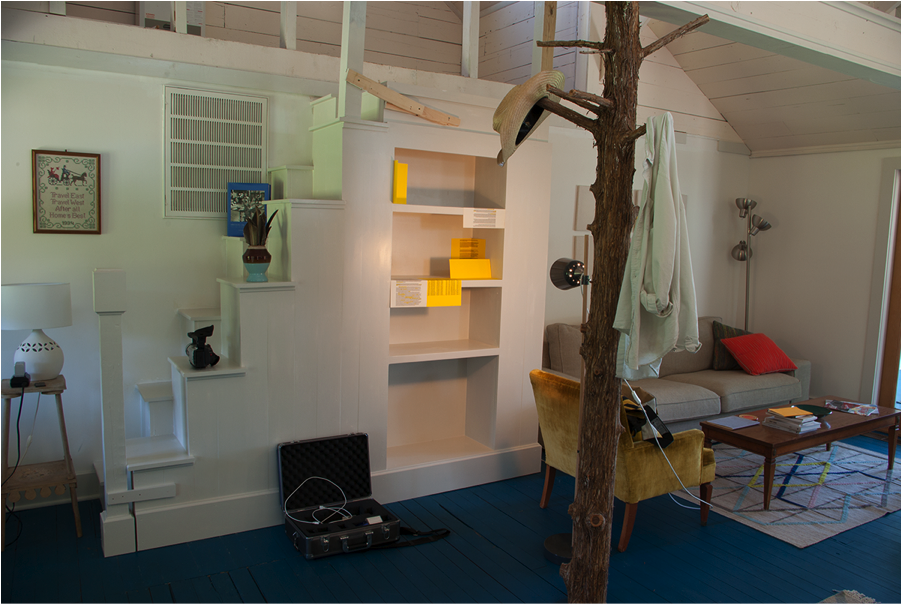James Woodfill
James Woodfill traveled to Prairieside Outpost from his home in Kansas City and in-between many projects. Jim Woodfill is a professor in the Painting Department at Kansas City Art Institute.
Residency at Prairieside Outpost
Matfield Green, Kansas
June 2014
DAY ONE: Inside the cottage.
The cottage is so welcoming – I immediately found the correct place to hang my hat. The work of this residency will be to “be here.”
Upon arrival I did some basic architectural assessment. The wall that separates the living room from the study is built to the height of the crossing beam allowing a view up to the slatted ceiling of the main structure with the roof pitch apparent from inside the study. This is the translucent room. It is the Hofstadter translucent reading room. It is the office for the week.
The living room area has two reading zones. The first with black leather chairs is basically the front porch turned inside out. Fiction and poetry (inside/outside). Richter, Ryman, Kraus with moleskin on the coffee table in front of the couch.
I re-assessed my reading wishes for the week immediately when I saw the wonderful selection of books in the house library.
It is a beautiful immediate area, and just to go outside and find the complete rural environment lets the work in the office breath.
Spent the afternoon catching up on article reading. Took a walk.
—
DAY TWO: Inside out.
Walked out to exit 5 past Matfield Cemetery, from inside the town (Rogler Street I think). Exit 5 appears to be road 55. Walked down the highway and back in to exit 4.
Saw a doe in a yard on a dead end un-named street. We made eye contact for a while and then she left through a field. I ran into Strong City for supplies, and stopped by the Gallery at Pioneer Bluffs on the way back. I re-introduced myself to Ans, the proprietor of the gallery and the manager for Matfield Outpost. I met her husband Ton – both would continue to be present from time to time during the week, and they were always wonderful to see and very helpful.
The town is very small and it is easy to get around it – to discern its extents. From within its interior, it is dissolving back into the prairie.
There is still very much a sense of “inside” that pushes the highway to the periphery – to the edge or the outside, although there is a dense section of town along the west side of the highway. We can still be in town in a way that turns the perception of “just off of the highway” inside/out.
The streets seem to meander in and out of driveway/alley status. Following Commercial Street east, it meanders around behind some houses and for a moment seemed like an implement lot but then again addressed the grid of the town by coming up behind the old school buildings. This is where they keep the goats.
I recognize this town, this sense of place. While the small town I grew up in was much bigger, there were parts on the periphery that had been inadvertently severed from the main structure and had formed their own centrality only to have it fade. Or small subsets that were becoming little townships, or subsets that never quite formed into the main structure of the town. And there were small subsets surrounding the core of the county in all directions, having formed around a threshold of density formed by clusters of small farms. As cars replaced horses and walking, and later as farms consolidated, these small towns started to dissolve back into the landscape.
David Dowell and I wrote about the results of the highway cuts in Downtown Kansas City – how they caused a certain kind of separation that allowed new structures to form, like a clipping from a plant (or more interesting, a rhizome). The results are the Crossroads and the River Market, among others, and the extreme sprawl facilitated by the Interstates has further loosened to definitions of the original structure. What once were outposts have become dense centers in their own right. And the older cores are hollowing out.
Small towns and Cities in the Midwest – in these instances, these structures, over time, the organic nature of their formations is evident. They breathe in and out of the landscape. The lack of geographical boundaries facilitates a grand scale (space) inhabited by small pockets of human civilization.
Back to Matfield Green. A very small town. But there is self-similarity in the scale shift. And this place IS breathing in and out of the landscape. The surrounding environment has become an aesthetic encounter, surpassing an earlier pragmatic, functional USE of the land and the need for a township, which itself surpassed an earlier, perhaps, aesthetic/functional/pragmatic/spiritual INTERACTION/INTEGRATION with the land. What most likely started as a settlement that could be in service to the surrounding land use now turns itself inside out and becomes a facilitator to the experience of the Flint Hills.
OBSERVATIONS – GENERAL
This isn’t the pure wilderness – it has been and is inhabited by humans, but it is easy here to see human intent as just another force – the vegetation “intent” is not controlled here by humans, but mediated – and the human behavior is absolutely mediated by the vegetation.
The trains have a constant presence here.
—
DAY THREE: PLANE-PLAN
Yesterday was the start of PLANE-PLAN – this is a deviation of surface-plan. “Prints” used as mediations in space. Photography as memory or sketch. As construction. I found myself working in a very provisional way, the result of the choices I made to equip myself here, as well as some beautiful yellow paper I found.
Wednesday was a full day of this experiment, and it moved from the built-in shelves in the translucent room to the inset shelves in the almost completed new loft stairs. It also moved into a video experiment, although I doubt that gets attention out here.
My morning walk took me out of town on Bocook Street onto Little Cedar Creek Road, across a bridge over the South Fork of Cottonwood River. I kept seeing out in front of me the promise of a large vista over the next slight hill or past a tree row. I walked out to where this road turned to the south – where an un-named dirt road continued east to what was the horizon where I found a nice view up on the hill. It wasn’t until I turned around to go back that I realized I had unraveled one of the most beautiful views yet – back towards Matfield Green from on top of a “flint” hill.
I had a chance to chat with Mindy Graham, a local resident, for a bit, and I walked to Bill McBride’s studio and home down the highway. He had a series of maps that he was working on to view the Flint Hills from different frames of reference. One map showed the Flint Hills location through the interruptions of the ongoing 1 mile grid of roads throughout the state. It was amazing to see a large scale plan of this grid – the massive amount of organization we have layered onto the landscape. But in the Flint Hills, this organization dissolves to an extent. The road that I went up the hill for the view was an indicator of where that organization starts to fade and let go. I have been looking at the area from google maps, and when I got back I followed this road to the east – at some point it started to lose its straightness, shifting to more of a mowed path and finally tailing off as a trail that ended in the hills.
When we drive through the Flint Hills we see a continual series of vistas. At a walking pace, the route this morning reminded me of the long walk across Chain of Rocks Bridge in St. Louis in this way: from inside, the long steel truss bridge across the Mississippi stayed a solid form in the distance and continued to decompress into lace above you as you walked along – turn around and it was packing back up at the same pace behind you.
The walk out Little Cedar Creek Road was a slow motion unraveling of the compressed landscape. It seems as though walking to the east for 30 minutes was a process of stretching out the view. Walking back to town allowed the view to pack itself back up.
—DAY FOUR
A rainy day. This was the day I didn’t put any shoes on.
I continued to work on the PLANE-PLAN and got a bit into the video that I have been shooting of it, and I think there is a project in there somewhere. And finally the issues surrounding a book that Matt Wycoff and I are working on started to come into focus (one of my planned projects for this residency).
On day four I noticed the isolation. The early part of the day felt like some sort of rehab, where you are constantly reminded that you can’t have a cigarette. Alone with my thoughts. I work in isolation most of the time in the studio, but it is usually in partial-day long segments with phone calls, visits, walks – people.
My recent ancestors came to the Midwest before and right after the Civil War. Earlier this month, driving back from Tulsa, I drove close to where my great-great grandfather and various family members are buried – 30 or 40 miles north of Joplin on highway 43, in Barton County, Missouri. In that area, as in Chase County, the towns are thinning out, but unlike Chase County, there is no “new” life to turn things around. I contemplated then, as I did most of day four, what it must have been like to leave home and drift into this vast landscape – the isolation, the quiet. It only worked if you worked. They were kept busy by the harshness of survival.
A LONG WEEKEND VACATION
Kirsten (Gustafson) and Luna (Dog) arrived. We all went for a great walk to Matfield Station, via the back roads and walked up the hill behind Bill’s house through waist and chest high grasses and thicket. The view from the top was phenomenal.
The next morning started with a walk to the river down Bocook Street and then a large breakfast. Reading and office work.
The pace of these last few days changed, of course, and my writing here has been limited. Kirsten and Luna have joined me for many walks and we have made many observations, such as the peculiar chicken architecture with outbuilding.
Working in relation to such a serene environment allows a focus that cannot be duplicated, and the Flint Hills have given me a fresh sense of purpose. This residency has been such a wonderful experience.
Kirsten, Luna and I packed up and got ready to go home on Sunday morning. Before we headed out we took a drive south on one of the suggested routes and found a place to walk out into the landscape and say goodbye to this place.
I spent so much time earlier in the week with my camera on a tripod, looking through the lens with the studio work that I had set up that I did a poor job of photographing the landscape. I also find it somewhat intimidating given the spectacular work of artists like Mike Sinclair (who happened to be staying at Matfield Station with his wife Gayl over the weekend) and Lisa Grossman, whose work was on display at the Gallery at Pioneer Bluffs. Thankfully, Kirsten showed up with fresh eyes and an enthusiasm for images of the environment. I will wrap up this report with a selection of her images.















